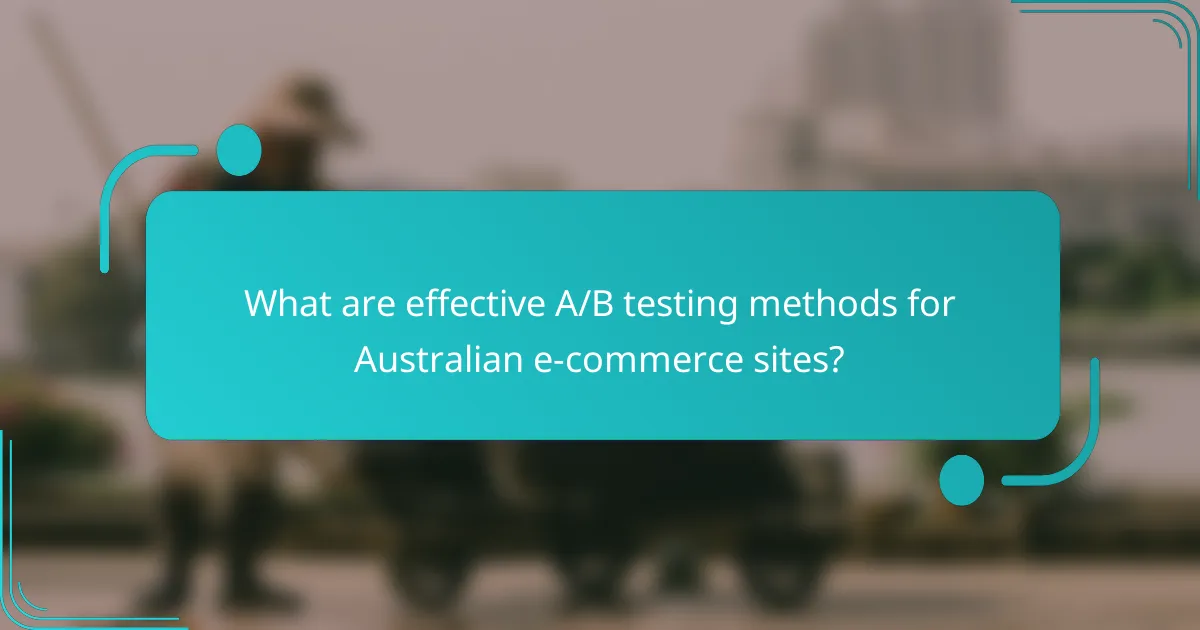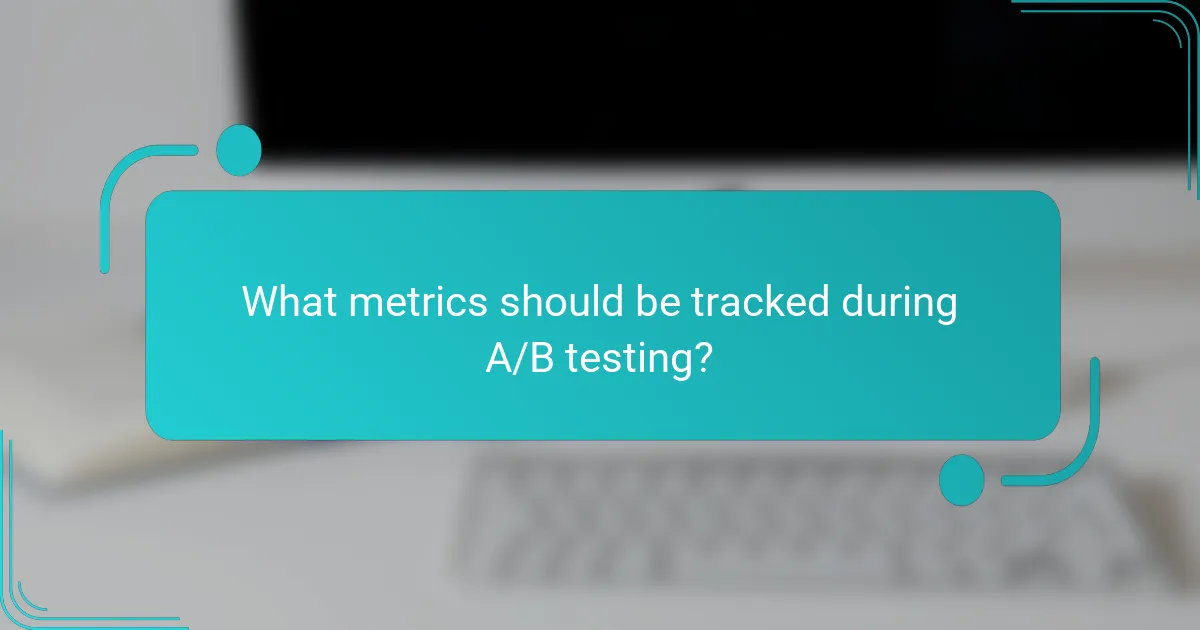Effective A/B testing methods for Australian e-commerce sites are essential for optimizing user experience and boosting conversion rates. By systematically comparing different webpage versions, businesses can make informed, data-driven decisions tailored to local preferences, ultimately enhancing their online performance.

What are effective A/B testing methods for Australian e-commerce sites?
Effective A/B testing methods for Australian e-commerce sites include various strategies that help optimize user experience and increase conversion rates. By implementing these methods, businesses can make data-driven decisions that enhance their online performance and cater to local preferences.
Multivariate testing
Multivariate testing allows you to test multiple variables simultaneously to determine which combination yields the best results. For example, you might test different headlines, images, and call-to-action buttons on a product page. This method can provide insights into how various elements interact with each other, leading to more effective designs.
When conducting multivariate tests, ensure you have enough traffic to achieve statistically significant results. It’s advisable to run these tests for several days or weeks, depending on your site’s traffic volume, to gather reliable data.
Split URL testing
Split URL testing involves creating separate URLs for different versions of a webpage to compare their performance. This method is particularly useful for testing major changes, such as a complete redesign or a new layout. By directing a portion of your traffic to each URL, you can analyze metrics like bounce rates and conversion rates to determine which version performs better.
Keep in mind that split URL testing may require more technical setup and can be more complex than traditional A/B testing. However, it provides clearer insights into user behavior across entirely different page designs.
Sequential testing
Sequential testing is a method where you test one change at a time over a series of iterations. This approach allows you to isolate the impact of each modification, making it easier to understand what works and what doesn’t. For instance, you might first test a new product image, followed by a change in the product description.
This method is particularly beneficial for sites with lower traffic, as it reduces the risk of confounding variables affecting your results. However, it can take longer to reach conclusions since each test must be completed before the next begins.
Mobile optimization testing
Mobile optimization testing focuses on enhancing the user experience for mobile visitors, which is crucial given the high percentage of Australians shopping via smartphones. This testing can include adjustments to layout, button sizes, and loading speeds. By ensuring your mobile site is user-friendly, you can significantly improve conversion rates.
Utilize tools that allow you to track mobile user behavior and test different mobile-specific designs. Aim for fast loading times, ideally under three seconds, and ensure that all elements are easily accessible on smaller screens.
Personalization strategies
Personalization strategies involve tailoring the shopping experience based on user data, such as browsing history or location. For Australian e-commerce sites, this might mean showcasing products that are popular in specific regions or offering localized promotions. Personalization can lead to higher engagement and conversion rates.
To implement effective personalization, use data analytics tools to segment your audience and create targeted campaigns. Be mindful of privacy regulations, such as the Australian Privacy Principles, when collecting and using customer data for personalization efforts.

How can Australian e-commerce sites implement A/B testing?
Australian e-commerce sites can implement A/B testing by systematically comparing two versions of a webpage to determine which one performs better. This method allows businesses to make data-driven decisions that can enhance user experience and increase conversion rates.
Define clear objectives
Establishing clear objectives is crucial for effective A/B testing. Objectives should be specific, measurable, and aligned with overall business goals, such as increasing sales, improving user engagement, or reducing bounce rates.
For example, an objective could be to increase the conversion rate of a product page by 15% over the next quarter. This clarity helps in designing tests that directly impact the desired outcomes.
Identify key performance indicators
Key performance indicators (KPIs) are essential for evaluating the success of A/B tests. Common KPIs for e-commerce sites include conversion rates, average order value, and cart abandonment rates.
By tracking these metrics, businesses can assess which version of a webpage is more effective. It’s advisable to focus on a few critical KPIs rather than overwhelming yourself with too many metrics, which can dilute insights.
Use A/B testing tools like Optimizely
Utilizing A/B testing tools such as Optimizely can streamline the testing process for Australian e-commerce sites. These platforms offer user-friendly interfaces and robust analytics to help businesses conduct tests efficiently.
Optimizely allows users to create variations of web pages without needing extensive coding knowledge. Additionally, it provides real-time data on user interactions, enabling quick adjustments based on performance. Other tools worth considering include Google Optimize and VWO, which also cater to various testing needs.

What are the best practices for A/B testing?
The best practices for A/B testing involve systematic approaches to ensure reliable results. Focus on testing one variable at a time, ensuring a sufficient sample size, and running tests for an adequate duration to draw meaningful conclusions.
Test one variable at a time
Testing one variable at a time is crucial for isolating the effects of each change. For example, if you alter both the button color and the call-to-action text simultaneously, it becomes difficult to determine which change influenced user behavior.
By focusing on a single element, you can clearly identify its impact on key performance indicators (KPIs) such as conversion rates. This method simplifies analysis and helps avoid confusion in interpreting results.
Ensure sufficient sample size
A sufficient sample size is essential to achieve statistically significant results. For Australian e-commerce sites, aim for hundreds to thousands of visitors per variation to ensure that your findings are reliable and not due to random chance.
Using online calculators can help determine the required sample size based on your current conversion rates and the minimum effect you wish to detect. Avoid small sample sizes, as they can lead to misleading conclusions.
Run tests for adequate duration
Running tests for an adequate duration is vital to capture variations in user behavior over time. A typical testing period might range from one to four weeks, depending on your traffic levels and the nature of the changes being tested.
Short tests may not account for fluctuations in user activity, such as weekends or holidays. Ensure that your test runs long enough to include diverse user interactions, providing a more comprehensive view of performance changes.

What are common mistakes in A/B testing?
Common mistakes in A/B testing can lead to inaccurate results and wasted resources. Avoiding these pitfalls is essential for effective decision-making in Australian e-commerce.
Ignoring statistical significance
Ignoring statistical significance can result in drawing conclusions from random variations rather than actual changes. It’s crucial to ensure that your sample size is large enough to achieve reliable results, typically aiming for a confidence level of at least 95%.
To assess statistical significance, use tools like A/B testing calculators that help determine whether the observed differences are likely due to chance. This practice prevents premature decisions based on inconclusive data.
Testing too many variables
Testing too many variables at once can complicate the analysis and obscure which changes are responsible for any observed effects. Stick to one or two variables per test to maintain clarity and focus.
For example, if you’re testing a new product page layout, consider changing only the call-to-action button color or the placement of images. This approach simplifies interpretation and enhances the reliability of your findings.
Not segmenting audience
Not segmenting your audience can lead to misleading results, as different customer groups may respond differently to changes. Segmenting by demographics, behavior, or purchase history allows for more tailored insights.
For instance, an A/B test on a discount offer might yield different responses from first-time buyers compared to repeat customers. Analyzing these segments separately can help refine strategies and improve overall conversion rates.

What tools are recommended for A/B testing in Australia?
For effective A/B testing in Australia, tools like Google Optimize and VWO are highly recommended. These platforms provide user-friendly interfaces and robust features tailored for e-commerce sites, allowing businesses to optimize their online performance efficiently.
Google Optimize
Google Optimize is a free tool that integrates seamlessly with Google Analytics, making it ideal for Australian e-commerce businesses. It allows users to create experiments that test different versions of web pages to see which performs better in terms of user engagement and conversion rates.
To get started, simply set up an account, link it to your Google Analytics, and create your first experiment. Consider testing elements like call-to-action buttons, product images, or page layouts. A common pitfall is running tests for too short a duration; aim for at least a few weeks to gather meaningful data.
VWO
VWO (Visual Website Optimizer) is a comprehensive A/B testing tool that offers a range of features, including heatmaps and user recordings. It is particularly useful for Australian e-commerce sites looking to gain deeper insights into user behavior and preferences.
With VWO, you can easily set up tests without needing extensive coding knowledge. Focus on testing critical elements such as checkout processes or promotional banners. Remember to segment your audience effectively to ensure that your tests yield actionable insights. Avoid making changes to your site during testing, as this can skew results.